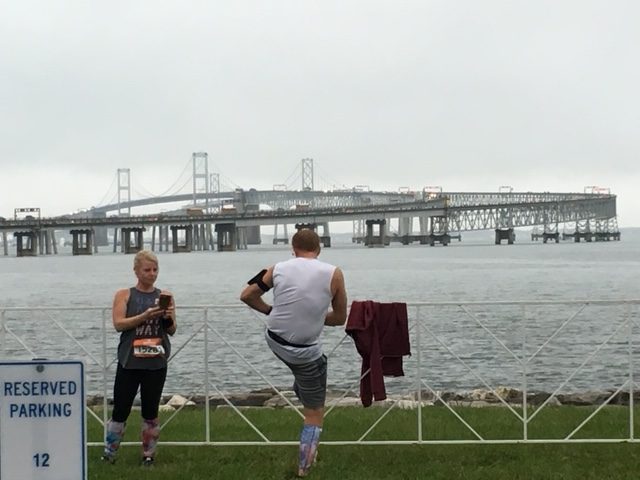
The Chesapeake Bay Bridge looms in the background behind Bay Bridge runners waiting to cross the bridge.
Please Follow us on Gab, Minds, Telegram, Rumble, GETTR, Truth Social, Twitter
I've heard this question many times since last Tuesday. There's something about watching a huge bridge get hit and knocked down by a container ship that makes many people wonder, could this happen to other bridges?
In Maryland this question looms large as residents consider the many bridges they have to cross to get to work and to the number one vacation spot in the state, the Ocean. As I sat in a doctor's office yesterday, an elderly lady asked it aloud. "Could this happen to the Bay Bridge?"
She confessed that she was already leery of the Bay Bridge, even though she had crossed it hundreds of times in her life. "It's scary." she declared," And I'm even more afraid now."
As someone who has not only driven across the Bay Bridge but done several footraces across it, I'll confess that the thought of something bad happening has crossed my mind.
But is it plausible or is that just the fearful brain creating possibilities we don't want to think about?
From CNN:
Twenty miles downstream, massive container ships headed to Baltimore also pass under the Chesapeake Bay Bridge near Annapolis. And according to experts who reviewed its design for CNN, it could also be at risk of collapse if one of those vessels rammed into it. Major US bridges could be vulnerable to ship collisions – including one just downstream from Baltimore’s Key bridge | CNN
Many bridges in the United States have defensive measures set up to prevent what happened at the Key Bridge including huge concrete "deflectors" that keep ships from impacting the support structures of the bridge according to structural engineering experts.
The Key Bridge didn't have those. And the Bay Bridge has less significant defenses as well, leaving it to be vulnerable to what they call a "critical fracture member" which is a support of the bridge that, when knocked down or severely damaged, could potentially bring down the entire structure or at least part of it.
There are several ways to protect bridges. "Fenders" are structures that are attached to the bridge support and can withstand the impact of a large ship, thus keeping the support from failing. Another option is "dolphins" which are large, circular cement structures place around bridge supports that will keep ships from hitting the main bridge.
The Key Bridge had dolphins. The ship, the Dali, never hit the dolphin but headed in an angle that missed the dolphin and hit the bridge instead.
Barrier islands are another option. They would effectively ground the ship before it hit the bridge. Like most of the options, if they couldn't stop the ship, they could at least slow it down.
Of course, one factor of last week's tragedy is the increasing size and weight of these container ships. These factors also increase the damage they can do. So does the increase in the number of ships coming into these ports. Shipping is the lifeblood of the American economy, therefore more goods come in and out of our ports.
Officials across the country are now quickly inspecting bridges to determine if they are also vulnerable. In Maryland, the Maryland Transit Authority is currently reviewing protective measures at the State's bridges, especially the Chesapeake Bay Bridge. A spokesperson said that the agency and the Coast Guard are “looking at options with the U.S. Coast Guard on the feasibility of increased pier protections for the Bay Bridge and what’s possible in the navigation channel."
Currently the decking on one of the bridges is being replaced, but that has nothing to do with the collision issue. The possibility of a third bridge to ease traffic is decades away.
Experts disagree on whether any protective measures would have helped or would keep any bridge, even the Bay Bridge, completely safe. Many say that the best that can be done is mitigation of damage and casualties.
It's an issue that will be brought up consistently in the next months and years.
I just hope most of us don't worry about it as we drive over these bridges. Like most things in life, we have to believe that we are protected from harm.